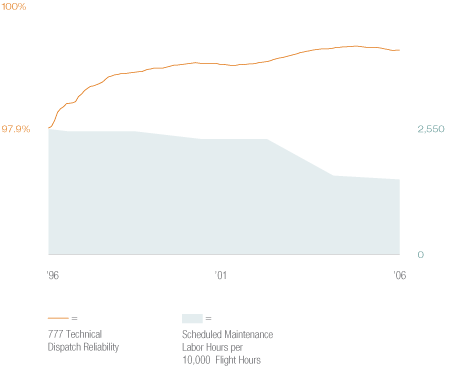
IN-SERVICE DATA COLLECTION AND ANALYSIS
Operators strongly influence the success of a scheduled maintenance program revision by providing in-service data. Boeing analyzes the fleetwide data provided by the operators to identify important trends for incorporation into the scheduled maintenance programs through the ISC process.
The operators and Boeing work together to identify areas within the scheduled maintenance program to review for optimization. In-service data is collected by the operators and sent to Boeing for review and analysis. For each identified maintenance task, Boeing reviews the data and analyzes the positive and negative in-service results. Boeing also reviews service bulletins, reliability data, service letters, airworthiness directives and any other pertinent documents, and coordinates proposed changes with other Boeing or supplier engineering groups.
Once the analysis is complete, Boeing makes a recommendation for each individual task under review and presents it to the ISC-participating operators and the regulatory agencies. Each operator is entitled to one vote on the Boeing proposal. The entire process is observed by the regulatory agencies, which ultimately can approve or reject any proposed changes. Accepted changes are incorporated into the MRBR, requiring acceptance from the MRB chairperson (the FAA and EASA). The changes are also incorporated into the Boeing Maintenance Planning Data (MPD) document and Boeing-configured task cards, which are issued to the operators for inclusion in their own scheduled maintenance programs.
The ISC process (see fig. 1) ensures that operators have efficient scheduled maintenance programs with the highest possible levels of safety and reliability. The combination of operators’ experience and Boeing’s design-based analysis ensures that all safety items on the airplane are supported by scheduled maintenance tasks with appropriate intervals. The result is increased reliability with decreased labor hours and maintenance costs (see fig. 2). Boeing engineering design groups can develop resolutions to technical issues arising from the in-service data. The new design or process changes can improve reliability and result in maintenance cost avoidance for the entire fleet.
| 777 TECHNICAL DISPATCH RELIABILITY AND SCHEDULED MAINTENANCE LABOR HOURS Figure 2 |
 |
|
Reduction in scheduled maintenance cost has had no adverse effect on technical dispatch reliability. |
777 SCHEDULED MAINTENANCE PROGRAM IMPROVEMENTS
A recent evaluation of the scheduled maintenance program for the 777 illustrates the ISC process. This evaluation included a review of approximately 400 777 maintenance tasks.
The new program extends the maintenance inspection interval for zonal and structural tasks, involving such areas as doors, fuselage compartments, struts, and flight controls, from 25 to 37 months. Under the previous MRBR, an airplane was pulled out of service for approximately 5 days to perform required maintenance checks every 25 months. The addition of 12 months to this maintenance interval provides significant financial and scheduling opportunities to 777 operators. Other tasks that have been escalated in the new maintenance program include many general inspections, which have increased from 100 to 125 days.
The result saves more than 400 labor-hours per airplane per year and increases airplane availability by providing airlines with one additional day of revenue operation annually for each 777 in their fleet. Using industry averages, the reduced maintenance costs and increased revenue opportunities added more than $100,000 USD in annual value to each 777 in operation.
In total, the evaluation resulted in an escalation (i.e., lengthening of the interval between maintenance task accomplishment) of approximately 100 line maintenance phase check tasks (similar in content to the block program A-check) and approximately 250 hangar-level-check tasks (similar in content to the block program C-check). The ISC, however, did not escalate approximately 12 percent of the tasks reviewed and de-escalated (i.e., shortened the interval between maintenance task accomplishment) one task based on the findings from the in-service data.
For example, one task that was escalated on the 777 was “operationally check flight deck indicator lights in dim and bright mode,” which is considered an economic, not a safety, task. Operators provided 1,500 test results for this task with no adverse findings, and the ISC determined that the interval for this task could be extended from 1,200 to 1,500 flight hours. As with the other tasks that were escalated, this change enables operators to arrange their maintenance programs in a more efficient manner without compromising safety.
